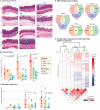In vivo physiological and transcriptional profiling reveals host responses to Clostridium difficile toxin A and toxin B
- PMID: 23897615
- PMCID: PMC3811747
- DOI: 10.1128/IAI.00869-13
In vivo physiological and transcriptional profiling reveals host responses to Clostridium difficile toxin A and toxin B
Abstract
Toxin A (TcdA) and toxin B (TcdB) of Clostridium difficile cause gross pathological changes (e.g., inflammation, secretion, and diarrhea) in the infected host, yet the molecular and cellular pathways leading to observed host responses are poorly understood. To address this gap, we evaluated the effects of single doses of TcdA and/or TcdB injected into the ceca of mice, and several endpoints were analyzed, including tissue pathology, neutrophil infiltration, epithelial-layer gene expression, chemokine levels, and blood cell counts, 2, 6, and 16 h after injection. In addition to confirming TcdA's gross pathological effects, we found that both TcdA and TcdB resulted in neutrophil infiltration. Bioinformatics analyses identified altered expression of genes associated with the metabolism of lipids, fatty acids, and detoxification; small GTPase activity; and immune function and inflammation. Further analysis revealed transient expression of several chemokines (e.g., Cxcl1 and Cxcl2). Antibody neutralization of CXCL1 and CXCL2 did not affect TcdA-induced local pathology or neutrophil infiltration, but it did decrease the peripheral blood neutrophil count. Additionally, low serum levels of CXCL1 and CXCL2 corresponded with greater survival. Although TcdA induced more pronounced transcriptional changes than TcdB and the upregulated chemokine expression was unique to TcdA, the overall transcriptional responses to TcdA and TcdB were strongly correlated, supporting differences primarily in timing and potency rather than differences in the type of intracellular host response. In addition, the transcriptional data revealed novel toxin effects (e.g., altered expression of GTPase-associated and metabolic genes) underlying observed physiological responses to C. difficile toxins.
Figures




References
-
- Lucado J, Gould C, Elixhauser A. 2012. Clostridium difficile infections (CDI) in hospital stays, 2009. HCUP statistical brief 124. Agency for Healthcare Research and Quality, Rockville, MD - PubMed
-
- Ghantoji SS, Sail K, Lairson DR, DuPont HL, Garey KW. 2010. Economic healthcare costs of Clostridium difficile infection: a systematic review. J. Hosp. Infect. 74:309–318 - PubMed
Publication types
MeSH terms
Substances
Grants and funding
LinkOut - more resources
Full Text Sources
Other Literature Sources
Molecular Biology Databases
Miscellaneous

